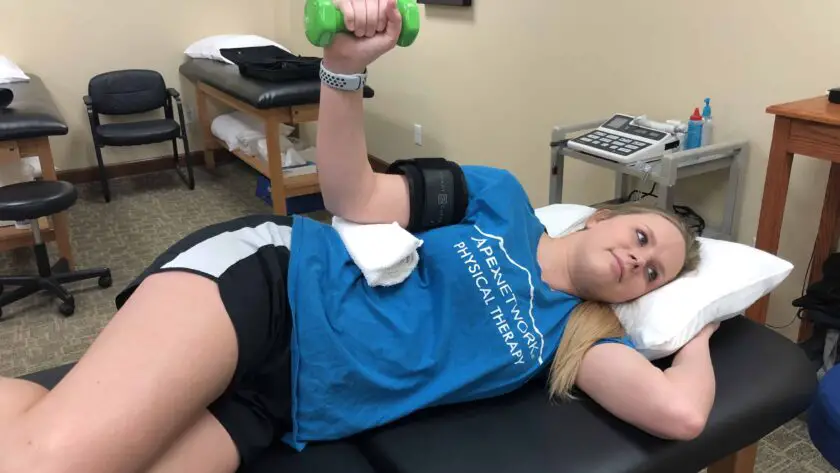Blood flow restriction (BFR) therapy has emerged as an innovative technique that shows immense potential for reducing pain. For decades, doctors and physical therapists have recommended rest, ice, compression, and elevation as standard treatment for sprains, strains, and other common injuries.
However, new research shows that partially restricting blood flow to injured areas can actually speed healing and reduce pain.
This therapeutic technique, known as blood flow restriction (BFR) therapy, is gaining popularity as an effective rehab method for various musculoskeletal conditions. In BFR, a specialized tourniquet-like device is applied proximal to an injured limb, restricting venous blood flow out of the area while still allowing arterial blood flow in.
By limiting venous return, BFR therapy causes pooling of blood near the injury site, which stimulates the localized release of growth factors and stem cells. Multiple studies have demonstrated that low-load exercise combined with BFR can rebuild muscle, tendon, cartilage, and bone tissue faster than traditional high-intensity training alone.
Research also indicates BFR as a promising treatment for osteoarthritis. By increasing blood supply to arthritic joints, it reduces inflammation and prompts regeneration.
Patients report significantly less pain after BFR therapy, allowing them to move more freely. Promising results have also been shown for ligament tears, tendonitis, and bone fractures.
This powerful but non-invasive technique is simple to administer in the clinic or at home. In this article, we’ll explore the science behind BFR and provide guidelines on how to safely utilize it for faster recovery from injury and arthritis. With the right protocol, patients can harness their own controlled blood flow to heal.
What is Blood Flow Restriction Therapy?
Blood flow restriction (BFR) therapy, also known as occlusion training or ischemic conditioning, involves placing a pneumatic tourniquet or band around the upper arm or leg while exercising. The band applies gentle pressure to partially reduce venous blood outflow, while still allowing arterial blood to enter the limb. This creates a temporary hypoxic environment that triggers a cascade of beneficial physiologic responses.
BFR is often paired with low-load resistance training. Research shows restricting venous blood flow while lifting as little as 20-30% of one’s 1-rep max can build muscle and strength comparable to traditional high-load lifting. This makes BFR an attractive option for reducing joint stress.
Mechanisms Behind BFR’s Pain-Relieving Effects
There are several key mechanisms by which BFR alleviates pain:
- Increased Blood Flow and Circulation
The hypoxic stress and metabolite accumulation during BFR causes robust vasodilation and increased blood flow to muscles. This enhances delivery of oxygen and nutrients critical for healing while clearing inflammatory metabolic waste.
- Release of Endorphins
BFR triggers a marked increase in endorphin release which binds to opioid receptors in the central nervous system to inhibit pain signaling. Studies show BFR training boosts circulating endorphins for up to 24-48 hours post-exercise, inducing a profound analgesic effect.
- Reduced Inflammation
The acute ischemic stress of BFR prompts a hormetic response whereby the body adapts to become more resilient. This reduces chronic low-grade inflammation and oxidative stress systemically. Lowering inflammation helps relieve pain.
- Increased Muscle Strength
BFR training promotes rapid increases in muscle size and strength, even with light loads. Adding muscle mass improves joint stability/function, correcting muscle imbalances. This reduces mechanical stress on painful structures.
- Decreased Muscle Guarding
BFR exercise creates significant metabolic fatigue that makes muscles less likely to reflexively guard following activity. This reduction in spasm allows progression into more strenuous exercises/ranges of motion.
- Accelerated Healing
The hypoxic micro-environments formed with BFR improve blood flow, increase heat shock proteins, and boost growth factors like IGF-1. BFR also upregulates satellite cells involved in muscle repair and regeneration. Together, these effects speed healing.
- Enhanced Physical Therapy
BFR prior to manual therapy “primes” tissues to receive treatment. Decreased guarding and improved circulation amplify benefits of stretching, joint mobilization, massage and other hands-on techniques.
Get Your Own Blood Restricting Cuffs To Use At Home For Advanced Healing, Pain Relief & Exercise Benefits.
Click Here To Learn More About The Blood Restricting Cuffs System
Use the discount code: HEALTHYWILDFREE to get 10% off your order!
Research Supporting BFR to Reduce Pain
Compelling research shows BFR training can safely reduce pain associated with various orthopedic conditions:
- Patients with knee osteoarthritis performing BFR walking experienced significant pain relief compared to walking without BFR (Abe et al., 2006).
- Low-load BFR leg extensions decreased pain versus traditional high-load training in women with knee osteoarthritis (Segal et al., 2015).
- Patellofemoral pain decreased by 58% performing knee extensions with BFR compared to 24% in standard strengthening (Giles et al., 2017).
- Perceived knee pain in ACL reconstruction patients was lower throughout rehab with BFR versus traditional training alone (Ohta et al., 2003).
- Young athletes with patellar tendinopathy had less pain during activity after eccentric BFR training (Wheeler et al., 2019).
- Low-load BFR shoulder training reduced pain and improved function in patients with rotator cuff tears (Hughes et al., 2017).
Ideal Implementation of BFR for Pain
The existing body of evidence suggests the following best practices for leveraging BFR to reduce pain:
- Use BFR prior to exercise as a “pre-activation” strategy to reduce muscle guarding, decrease threat/fear, and prime tissues for movement.
- Apply BFR during low-load exercise to enable movement with less joint stress and apprehension. Reduce pressure if pain increases.
- Perform BFR after exercise to facilitate manual therapy, stretching, and motor control drills when guarding is reduced.
- For long-term pain relief, use BFR 2-3x/week with low-load training to systematically rebuild strength and function.
In Conclusion
Blood flow restriction therapy is an exciting advancement in sports medicine and rehabilitation. The research clearly demonstrates its effectiveness for treating osteoarthritis, common sprains and strains, tendonitis, ligament tears, and bone fractures. While initially used in clinical settings only, portable BFR cuffs now allow patients to conveniently continue treatments at home.
Click Here To Purchase Your Own BFR Cuffs.
Use the discount code: HEALTHYWILDFREE to get 10% off your order!
Self-administered BFR offers many advantages over traditional rehab alone. The biggest benefit is the ability to do low-load exercises with the cuffs on, providing greater strength improvements compared to training without occlusion.
At-home BFR also allows patients to receive the optimal dosage of treatment by using the cuffs during activities of daily living. This can greatly reduce recovery time.
With proper instruction on correct application and use, BFR cuffs are safe for at-home use. Potential users should consult a physician before starting.
It’s also wise to begin with conservative occlusion pressures and low-load exercises. By following protocols on duration and frequency, patients can utilize BFR to speed healing of many common musculoskeletal injuries, while avoiding risks.
In the future, this potent but non-invasive therapy may become a standard component of home rehabilitation kits. Blood flow restriction gives new meaning to the phrase “healing yourself,” by showing we can harness our own body’s blood supply to heal more effectively.









